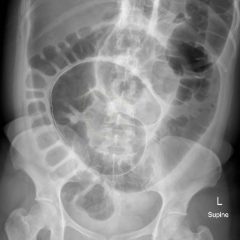Pneumonia Diagnosed by Point-of-Care Ultrasound
History of present illness:
A 46-year-old female was sent to the emergency department from clinic with an oxygen saturation of 86%. She endorsed fevers with cough and generalized weakness for one week. She had been evaluated by her primary care provider on day two of illness and was started empirically on Oseltamivir without improvement of her symptoms. The patient arrived febrile, tachycardic, tachypneic, and hypoxic on room air with left-sided crackles on exam.
Significant findings:
Point-of-care ultrasound of the left lower lobe demonstrates lung hepatization, a classic finding for pneumonia. In addition, a shred sign is present with both air bronchograms and focal B-lines—all suggestive of poorly aerated, consolidated lung.1 The patient was started on antibiotics and admitted to the hospital with a diagnosis of community-acquired pneumonia.
Discussion:
With a systematic approach, a skilled clinician can distinguish patterns on point-of-care ultrasound to evaluate for underlying pathology of the lung. Such findings include focal B-lines, an artifact that results from altered fluid-air compositions in the alveoli.2,3
Studies show, that when referenced with the gold standard of computed tomography, ultrasound is more sensitive than chest X-ray in diagnosing pneumonia. Nazerian et al.4 conducted a 190-patient study in which ultrasound had a higher sensitivity—81% compared to a dismal 65% by chest X-ray. Similarly, Cortellaro et al.5 concluded bedside ultrasound (96% sensitivity) is a reliable and superior tool for timely diagnosis of pneumonia compared to chest X-ray (69% sensitivity).
Bourcier et al.6 drew conclusions on the effectiveness of ultrasound over chest X-ray on two groups of patients. In the group who exhibited symptoms for less than 24 hours, ultrasound outperformed chest X-ray, where the PPV of ultrasound was 76% and chest X-ray 23%. For those who exhibited symptoms for more than 24 hours, ultrasound demonstrated a PPV of 93% while chest X-ray only 77%. Thus, the use of point-of-care ultrasound in the diagnosis of pneumonia can improve sensitivity while minimizing radiation.
Topics:
Pneumonia, ultrasound, dyspnea, shortness of breath, hypoxic, respiratory, pulmonology.
References:
- Rambhia SH, D’Agostino CA, Noor A, Villani R, Naidisch JJ, Pellerito JS. Thoracic ultrasound: technique, applications, and interpretation. Curr Probl Diagn Radiol. 2017;46(4):305-316. doi: 10.1067/j.cpradiol.2016.12.003
- Lee FCY. Lung ultrasound—A primary survey of the acutely dyspneic patient. J Intensive Care. 2016;4(1):57. doi: 10.1186/s40560-016-0180-1
- Barlam TF, Kasper DL. Pneumonia and lung abscess. In: Fauci AS, Kasper DL, Longo DL, Braunwald E, Hauser SL, Jameson JL, Loscalzo J, eds. Harrison’s Principles of Internal Medicine. 17th New York, NY: McGraw-Hill; 2011:764-767.
- Nazerian P, Volpicelli G, Vanni S, Gigli C, Betti L, Bartolucci M, et al. Accuracy of lung ultrasound for the diagnosis of consolidations when compared to chest computed tomography. Am J Emerg Med. 2015;33(5):620-625. doi: 10.1016/j.ajem.2015.01.035
- Cortellaro F, Colombo S, Coen D, Duca PG. Lung ultrasound is an accurate diagnostic tool for the diagnosis of pneumonia in the emergency department. Emerg Med J. 2012;29(1):19-23. doi: 10.1136/emj.2010.101584
- Bourcier JE, Paquet J, Seinger M, Gallard E, Redonnet JP, Cheddadi F, et al. Performance comparison of lung ultrasound and chest X-ray for the diagnosis of pneumonia in the ED. Am J Emerg Med. 2014;32(2):115-118. doi: 10.1016/j.ajem.2013.10.003


